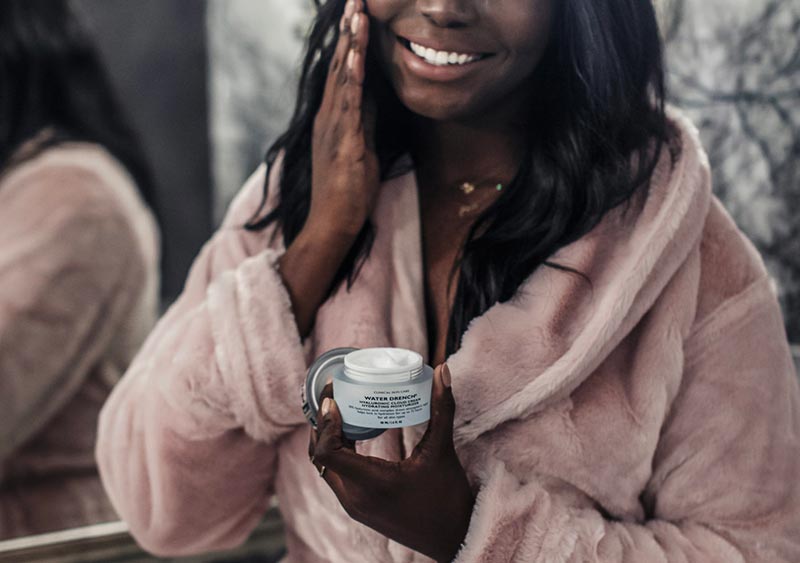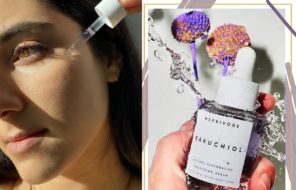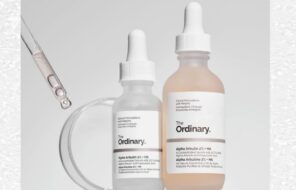Most women could agree on the foundational aspirations of their beauty routine: sublime moisture. Renewed vibrancy. Alluring elasticity. But is hyaluronic acid (HA) the modern fountain of beauty that will help you achieve these goals – one which will help you evade wrinkles and achieve supple skin texture for good? Or is it merely the latest manifestation of an evocative and elusively named formula that falls flat of our collective expectations?
In this article, we will analyzie hyaluronic acid for skin, all of its benefits and potential side effects. Also, learn how to incorporate hyaluronic acid skin care into your beauty routine.
In this article:
- What Is Hyaluronic Acid?
- How Does Hyaluronic Acid Work?
- Hyaluronic Acid Formulas for Skin Care
- Hyaluronic Acid Benefits
- Hyaluronic Acid Side Effects
- How to Use Hyaluronic Acid in Your Skincare Routine?
What Is Hyaluronic Acid?
Hyaluronic acid may be experiencing a golden moment but it wasn’t exactly conjured out of the thin air of a beauty editor’s newsroom. Hyaluronic acid has its origins in the natural world and it is chemistry that endows it with its power.
Hyaluronic acid is a naturally occurring carbohydrate polysaccharide that is found in the human body. Unlike its exfoliating counterparts salicylic and glycolic acid, hyaluronic acid is a lubricant that nourishes rather than exfoliates. It lubricates your joints, eyes, nerves, and hair.
Hyaluronic acid is a flexible, viscous, and pillowy substance and 50% of your body’s supply is found in your skin tissues. Hyaluronic acid’s most desirable quality? It is a humectant and one of the thirstiest biological substances around.
HA molecules have the ability to hold 1000 times their weight in water! One gram of hyaluronic acid can hold up to six liters of water. Those are some well-moisturized and hydrated molecules! What this means for you is less transepidermal water loss, essentially, less evaporation of surface moisture into the atmosphere.
HA clings onto that moisture and it ain’t letting go! But not all hyaluronic molecules are created equal. Why? A sexy thing known as molecular weight!
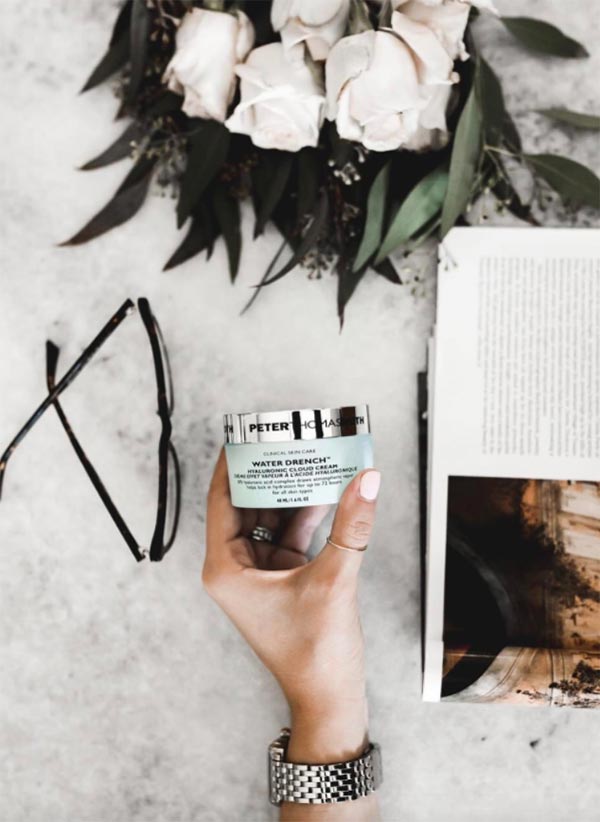
Molecular weight refers to the mass of the HA, and is measured in unified atomic mass units, kDa for short. For beautifying purposes, HA molecules with a weight ranging from 50 and 1000 kDa are most beneficial. 130 kDa is the magic number according to scientific studies. They arrived at this number by discerning that products containing HA with a kDa of 130 were the most successful at improving skin elasticity.
HA molecules with a mass exceeding 1000 will be ineffective. A kDa lower than 50 may inflame the skin. The diameter of the molecule is also a salient factor, as it determines the ability of the HA to penetrate the skin layers. Without this ability the moisture would sit ineffectively on the skin layer without creating long-term improvements in skin hydration or elasticity.
Smaller molecules (under 500 kDa) were discovered to be most effective at increasing elasticity, reducing the depth of wrinkles, and had faster absorption rates. Molecules over 500 kDa were less amenable to absorption, which reduce the anti-ageing capacities of the hyaluronic acid.
How Does Hyaluronic Acid Work?
What have we learned? Hyaluronic acid is not the beauty-sphere flavor of the week but is rather a vital part of your skin composition. Lucky enough to have supple, smooth, and velvety skin? You can thank hyaluronic acid for that.
The caveat to this generous beautifying agent? Its production naturally declines as the body ages, and this decline is a leading reason for the natural development of dryness, fine lines, and wrinkles over time. UV exposure and interactions with environmental irritants also work to degrade your natural supply of hyaluronic acid over time.
Lab-designed hyaluronic acid skin products are a weapon against this process, and work to combat the disintegration of the substance in the skin cells. Synthetic hyaluronic acid works to replenish lost stores of the acid and enhance existing supplies in the skin. And while nothing can identically mimic the complex production powerhouse that is the human body, some of the newest players on the market (which we’ll explore further in the following sections) come pretty darn close.
Still convinced hyaluronic acid is a creepy chemical with origins somewhere in outer space? It is a naturally occurring compound in leafy greens like kale and spinach, and you can increase your body’s stores of the stuff by doubling up on your green veggies! It can’t get more down to earth than that!
Hyaluronic Acid Formulas for Skin Care
Hyaluronic acid is certainly a shapeshifter. It can be found in a plethora of skincare formulas and comes in a variety of consistencies. Some of its most popular reincarnations include hyaluronic acid serums, moisturizers, and injectables.
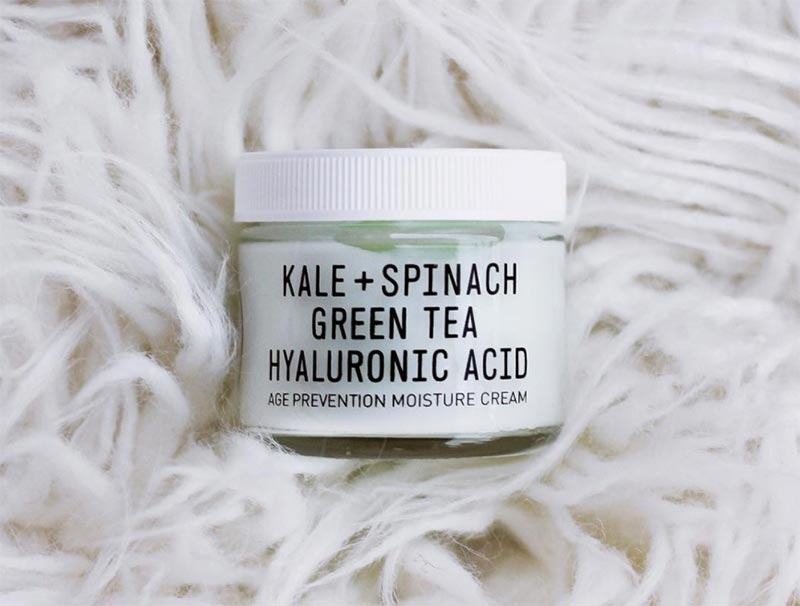
Hyaluronic Acid Serums
Hyaluronic acid serums are the most powerful form, as they are highly concentrated. Serums are like the vodka shot of the skincare world and are perfect for women who want potent and fast-acting results.
Hyaluronic acid serums typically contain smaller, more penetrative, molecules than cream-based moisturizer formulas. Scientists are producing formulas with even smaller molecular weights, allowing for deep skin penetration and more potent results.
We recommend looking for hyaluronic acid serums that contain a minimum of 1% hyaluronic acid to ensure your product is infusing your skin with all of the acids established benefits.
Perfect for dry to normal to oily skin, serums should be applied 15 minutes prior to any additional steps in your skincare routine. The words hyaluronic acid, or its counterpart sodium hyaluronate, should be near the top or middle of the ingredient list.
Hyaluronic Acid Moisturizers
There is a new generation of skincare lotions and moisturizers that marry hyaluronic acid with other anti-aging substances like retinol and organic oils and botanical extracts. These hybrid products are perfect for women who want a soothing addition to their skinare routine.
Hyaluronic acid moisturizers are designed to hold onto moisture on the surface of the skin and increase general hydration. One of hyaluronic acid’s most wonderful qualities is that it is suitable for all skin types and can be used liberally and daily.
Did you know that when skin is dry, it overcompensates by ramping up production of oil? This leads to blackheads and breakouts. So hyaluronic acid indirectly decreases acne flare-ups over time because it naturally inhibits the skin from over-producing oil.
Hyaluronic Acid Makeup
Hyaluronic acid makeup is another example of the acid’s chameleon-esque capacities. While some of these formulas may be marketing fads, the addition of the acid can be beneficial in foundations, and concealers.
Because of its ability to draw in moisture and round out skin texture, hyaluronic acid-laden face makeup can create the appearance of smoother texture and a more vibrant tone. Even if you don’t choose HA infused makeup, all makeup products are generally compatible with HA serums and moisturizers, making them super easy to incorporate into your existing beauty routine.
Hyaluronic Acid Fillers and Injectables
Hyaluronic acid has long since migrated into the hallowed halls of the plastic surgeon’s office and can be found in injectable form for plumping and filling. Hyaluronic acid has swept collagen under the rug and has become the substance du jour for injectable procedures.
Once injected, the hyaluronic acid begins to soak up moisture and thus impart your skin with a lusher texture. Popular name brand fillers like Juvederm and Restylane are composed of hyaluronic acid.
These injections can last for up to a year before the injected hyaluronic acid naturally loses efficacy. And because it is a naturally occurring substance, there is a low chance that your body will reject the filler or create unappealing swelling.
Hyaluronic Acid Benefits
Like azelaic acid, there are many benefits of using hyaluronic acid skincare products, which are:
Moisturized and Rejuvenated Skin
Remember, hyaluronic acid is a humectant, which means it draws in moisture and holds onto it. This rejuvenates the skin by infusing it with hydration. Increased hydration leads to boosted skin elasticity and an improved and dewy texture.
Because hyaluronic acid sits on the surface of the skin absorbing moisture, it lifts and fills skin out, making it look toned and pillowy. The result is refreshed skin with less visible wrinkles. This collection of hyaluronic acid benefits is what makes HA the perfect choice for women who are concerned about aged or dehydrated skin.
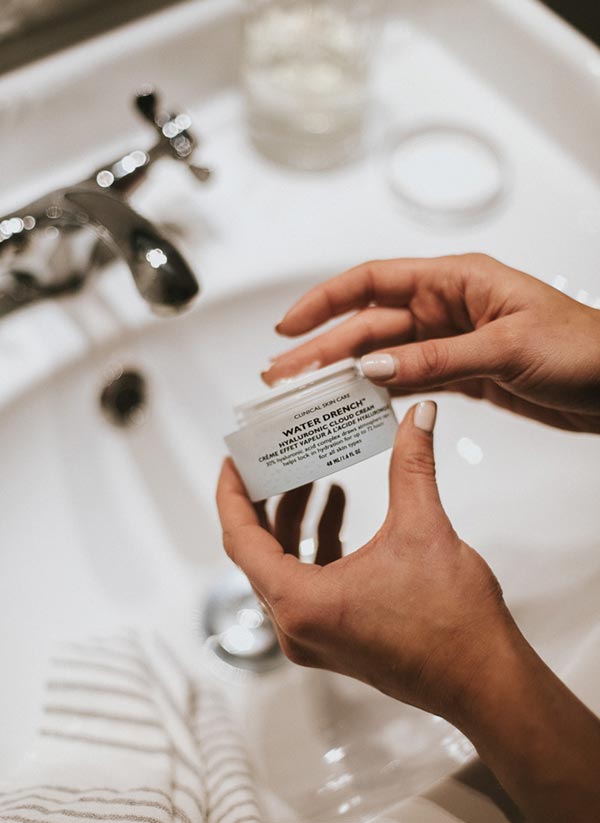
Decreased Appearance of Wrinkles
Similar to the aforementioned benefit, HA decreases the appearance of wrinkles and fine lines by imparting the skin with needed hydration. Wrinkles are formed because the skin loses elasticity over time, and moisture is drawn from the surface of the skin.
When applied topically, hyaluronic acid gently fills out fine lines by creating a more supple skin texture. For the quickest fix, a filler like Juvederm will have the most potent results.
Frequent use of hyaluronic acid skin products minimizes the appearance of pores over time as it reduces inflammation and tightens the skin while plumping it.
Hyaluronic Acid Acts as a Barrier
Because of the thick layer of moisture that imparts on the skin, hyaluronic acid-based products create a barrier between the skin and environmental irritants and toxins. It is no lie that hydrated skin is less susceptible to inflammation, and in a roundabout way the frequent application of hyaluronic acid skincare products helps heal the skin and repair cells from the effects of dehydration and exposure to drying agents and pollutants.
Hyaluronic Acid’s Antioxidant Properties
An extra dose of hyaluronic acid moisturizer can be beneficial in warmer months, when UV exposure increases the production of free radicals in the skin and degrades collagen stores. Hyaluronic acid is a line of defense against this, as it provides antioxidants to the skin.
The added benefit of this blessed property is that it aids in healing wounds and can be an antidote to facial redness and eczema. HA’s antioxidant properties lead to rejuvenated and vibrant skin with consistent use.
Hyaluronic Acid Is Universally Appropriate
Hyaluronic acid is beneficial for all skin types. Whether you have dry, oily, or breakout proof skin, there is a blend for you! Unlike exfoliating acids, HA is soothing and gentle enough for even the most sensitive of skin profiles.
Hyaluronic acid will be like a moisture shot for dry skin types and will add hydration to oily skin without the added greasiness that can be part and parcel with many other moisturizing products.
Hyaluronic acid is, in fact, a top contender for women with acne-prone skin because of its water-light, weightless consistency and thin texture. It won’t clog pores or ramp oil production into overdrive.
Dehydrated skin is often the culprit behind blemishes, and HA rectifies this concern.
An Important Disclaimer
We want to clarify one important disclaimer: hyaluronic acid should not be treated as a one-stop shop anti-aging product. They are perfect for saturating the skin and providing a lush moisture to skin texture but should be one element of a more comprehensive anti-aging regimen.
Hyaluronic Acid Side Effects
Hyaluronic acid’s soothing and anti-inflammatory effects can be traced to its natural occurrence in the human body. Quite simply, externally incorporated hyaluronic acid is not treated as a foreign object by the body, and this familiarity breeds a copacetic relationship between your skin and your hyaluronic acid serums.
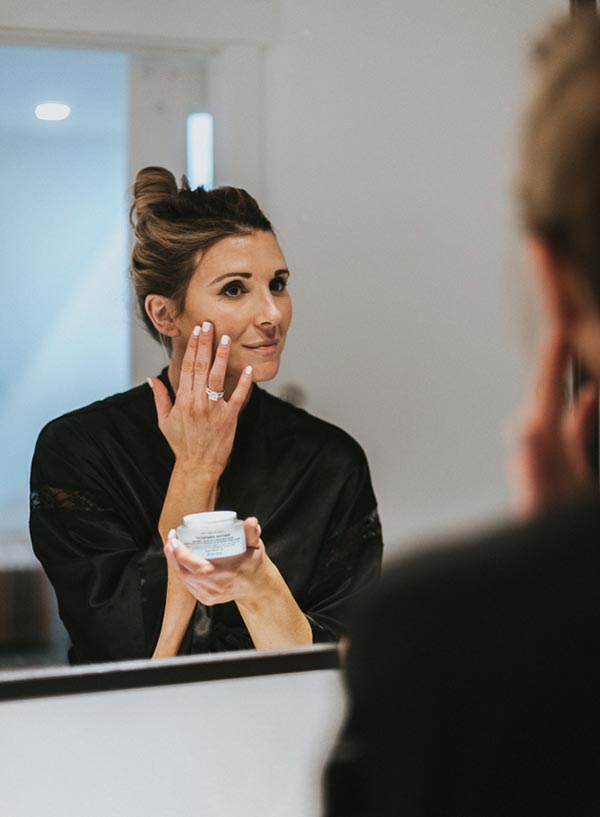
While hyaluronic acid skincare products are generally created with HA that has a suitable molecular weight, be advised that a low-molecular weight like 5 kDa can be detrimental to the skin. It is highly penetrative, and can bring with it unwelcome visitors like environmental pollutants and irritating bacteria. This can inflame skin and degrade texture over time.
Hyaluronic acid is a powerful moisturizer but acolytes must be wary of over-applying in dry climates. Because of its magnetic attraction to water molecules, it will pull the moisture from your skin if it can’t quench its thirst from the surrounding environment. This means that hyaluronic acid shines its brightest in more humid, or wetter environments.
Some women complain that hyaluronic acid dries out their skin. Although this is rare, some women’s unique skin chemistry can create this result. We advise that women who experience dryness continue incorporating HA into their skincare routine but double up on moisturizer. Even better? Choose a moisturizing cream formula instead of the more potent HA serum formula.
How to Use Hyaluronic Acid in Your Skincare Routine?
Regardless of consistency, a sound skincare routine should begin with a gentle cleanser, a finely milled exfoliator, and a toner (particularly for women with normal or combination skin).
Want in on a nifty skincare routine tip? Consistency is key! Always begin your skincare routine with the lightest weight products first and the heaviest last. Instead of lumping all hyaluronic acid products under one umbrella, view them as being categorized by their respective textures.
For example, a hyaluronic acid serum should be applied before your moisturizer, and eye cream, while a hyaluronic acid moisturizer can be saved for the end of your skincare routine.
Hyaluronic acid can be used twice daily, in the morning and before bed. It is gentle enough that women with sensitive skin can apply it frequently. It is most potent in serum form, and when using this formula, 2-4 drops should be sufficient. Blend into the skin and wait for the hyaluronic acid serum to dry before applying further products.
A hyaluronic acid moisturizer can be applied regularly, with circular motions. Allow the moisturizer to dry before applying makeup.
Hyaluronic acid can be used all over the face but do take some basic precautionary measures. Most hyaluronic acid serums are safe for using around the eyes, and can be applied on the eyelid, crow’s feet, and under the eyes. Avoid direct eye contact, and if you find irritation from using it on the lid, cease using it in this region.
Apply hyaluronic acid at the sides of the lips but avoid ingesting.
Photos via @cocobassey, Instagram

